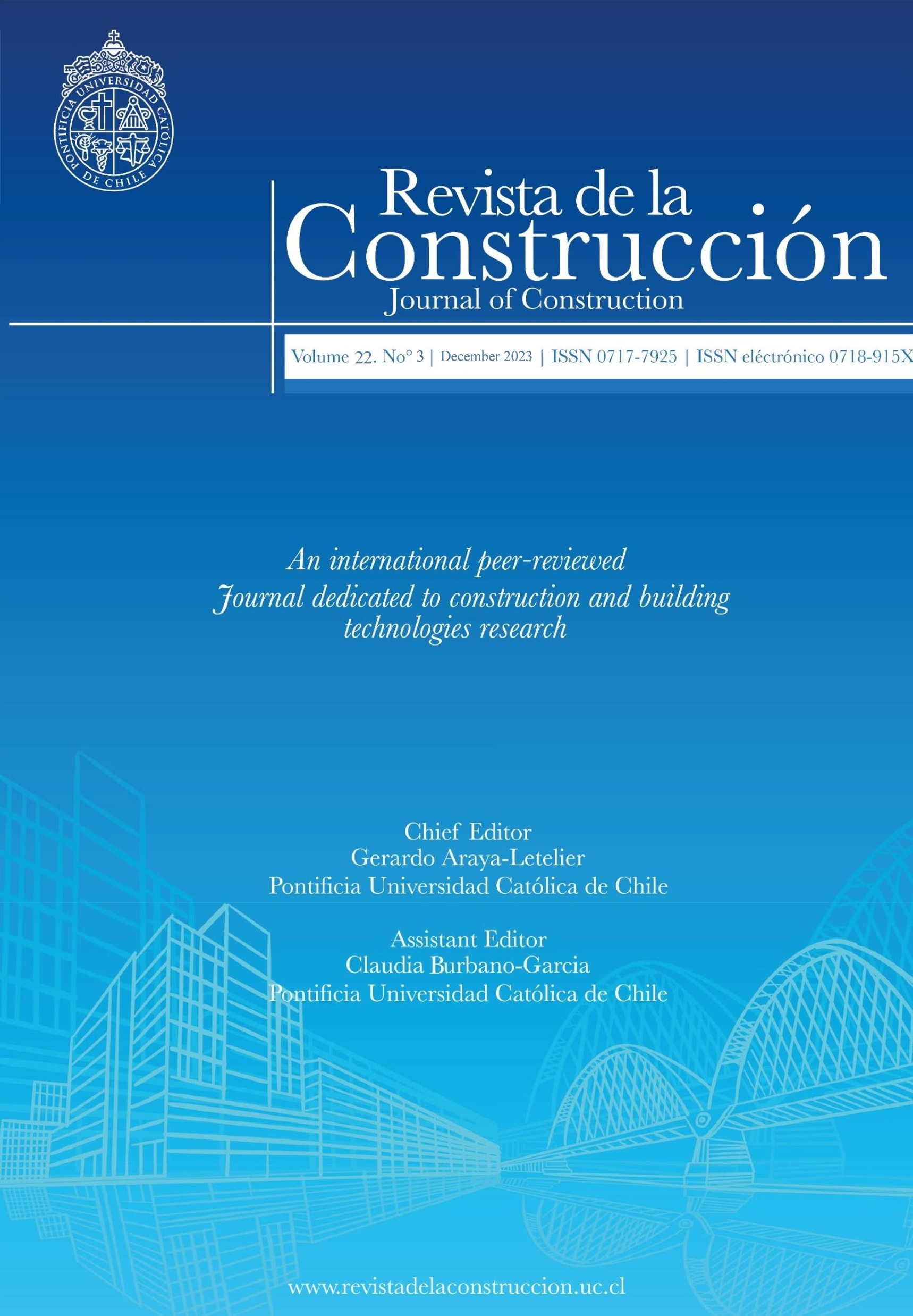Investigation of usability of mineral fiber in stone mastic asphalt
DOI:
https://doi.org/10.7764/RDLC.22.3.569Keywords:
Stone mastic asphalt, Schellenberger bitumen drain down test, Hamburg wheel tracking test, basalt fiber, cellulosic fiber.Abstract
Stone mastic asphalt (SMA) pavements were developed to prevent rutting, abrasion, and various pavement deteriorations and to increase the life of the superstructure. They certainly stand out with their high grain contact, stone-stone interlocking ability, and high bitumen ratio on heavy-traffic roads with heavy axle loads. This study aimed to investigate the effects of basalt fiber in different sizes, partly cellulose, and partly basalt fiber addition, on the drain down of the performance of bitumen and the changes in rutting performance as additives to stone mastic asphalt pavements. To determine the absorption performance of bitumen fiber additives, 19 mixtures were pre-pared and the Schellenberger drain down test was carried out. The results, including the witness mixture, showed that the Schellenberger test result was below the value specified in the motorway technical specification by a maximum of 0.3%. For the Hamburg wheel tracking test (HWTT) additive and witness mixtures were prepared at optimum bitumen ratios using a gyratory compactor. HWTT was applied to the mixtures numbered 1, 4, 10 and 14, which have the best the Schellenberger drain down performance, and the witness sample. As a result of the experiments, the highest rutting deformation was measured at the samples using 12mm basalt fiber at the rate of 0.2%. The lowest rut deformation was measured in samples containing 12mm basalt fiber at the rate of 0,3% and cellulose fiber at the rate of 0.2%. It was determined that the combined use of cellulose and basalt fiber mixture improved the resistance against rutting by 37%. As a result of the HWTT, it was determined that stone mastic asphalt mixtures with basalt and cellulose fiber additives were more resistant to rutting than the witness and basalt-only mixtures.
Downloads
References
Akpolat,M. (2022). Investigation of rutting, fatigue and cracking resistance parameters of CR modified warm asphalt binders compare with SBS modified binders. Revista de la Construcción 21.2: 309-328.
Altan, Ç. & Oral, G. (2022). Performance evaluation of porous asphalt mixtures modified with basalt fiber. Revista de la Construcción 21.1: 93-104.
Altan, Ç., Evirgen, B., Karslioglu, A., & Tuncan, A. (2020). The Effect of Basalt Fiber on the Performance of Stone Mastic Asphalt. Periodica Polytechnica Civil Engineering 65(1):2–10. doi: 10.3311/PPci.14190.
Aschenbrener, T., Terrel, R., L., & Zamora R. (1994). Comparison of the Hamburg Wheel Tracking Device and the Environmental Conditioning System to Pavements of Known Stripping Performance. Colorado Department of Transportation (January):110.
Aslan, Ş. & Aktaş, B. (2018). Use of diatomite and pumice as stabilizers in stone mastic asphalt mixtures. Revista de la Construcción DOI: 10.7764/RDLC.17.3.531
ASTM International (2003). Standard Test Method for Resistance to Degradation of Small-Size Coarse Aggregate by Abrasion and Impact in the Los Angeles Machine 1. 04:4–7.
ASTM International. (1999). Test Method for Soundness of Aggregates by Use of Sodium Sulfate or Magnesium Sulfate. Annual Book of American Society for Testing Materials ASTM Standards,West Conshohocken, USA, 04:1–5. doi: 10.1520/C0088-13.2.
Cooley Jr. L., A., Kandhal, P., S., Buchanan M. S., Fee F., & Epps. A. (2000). Loaded Wheel Testers in the United States: State of the Practice. Transporta-tion Research E- Circular, E-C016.
EAPA. (1998). Heavy Duty Surfaces the Arguments For SMA. European Asphalt Pavement Association.
Gang, D., Zheng, N., & Qie. L. (2013). Research on Influence of Different Fibers on Pavement Performance of SMA. Pp. 599–602 in Applied Mechanics and Materials. Vols. 253–255.
Huang, Y., Liu, Z., Liu, L., Zhang, Y., & Xu, Q. (2020). Hybrid Modification of Stone Mastic Asphalt with Cellulose and Basalt Fiber. Advances in Materi-als Science and Engineering 2020:5671256. doi: 10.1155/2020/5671256.
Izzo, R., & Tahmoressi, M. (1999). Use of the Hamburg Wheel-Tracking Device for Evaluating Moisture Susceptibility of Hot-Mix Asphalt. Transporta-tion Research Record 1681(1):76–85. doi: 10.3141/1681-10.
Jie, H., & Shiwakoti, H. (2016). Wheel Tracking Methods to Evaluate Moisture Sensitivity of Hot-Mix Asphalt Mixtures. Frontiers of Structural and Civil Engineering 10(1):30–43. doi: 10.1007/s11709-016-0318-1.
KGM. (2013). General Directorate of Highways of Turkey ‘Technical Speci_fication of Highways (TSH)’, Ministry of Transportation and Infrastructure, Ankara, Turkey, 2013. Karayolları Genel Müdürlüğü.
Mahrez, A., Karim, M., & Katman, H. (2003). Prospect of Using Glass Fiber Reinforced Bituminous Mixes. J East Asia Soc Trans Stud 5:794–807.
McDaniel, R., S., (2015). Fiber Additives in Asphalt Mixtures, National Academies of Sciences, Engineering, and Medicine. Washington, DC: The National Academies Press. https://doi.org/10.17226/22191.
Sharma, P. (2016). An Introduction to Basalt Rock Fiber and Comparative Analysis of Engineering Properties of BRF and Other Natural Composites. International Journal for Research in Applied Science & Engineering Technology 4(I):141–48.
Singha, K. (2012). A Short Review on Basalt Fiber. International Journal of Textile Science. 1(4):19–28. doi: 10.5923/j.textile.20120104.02.
Wan, C., G., Wang, Q., T., Ma, B., F., & Zhang, Y. (2014). Influence of Fiber Type on Road Performance of Stone Mastic Asphalt. Pp. 188–93 in Ad-vanced Materials Research. Vols. 912–914.
Wu, B., Wu, X., Xiao, P., Chen, C., Xia, J., & Lou. K. (2021). Applied Sciences Evaluation of the Long-Term Performances of SMA-13 Containing Differ-ent Fibers. Applied Sciences (Switzerland).
Downloads
Published
How to Cite
Issue
Section
License
Copyright (c) 2023 M.A. Rasekh, S. Haldenbilen, D. Zengin

This work is licensed under a Creative Commons Attribution-NonCommercial-NoDerivatives 4.0 International License.








